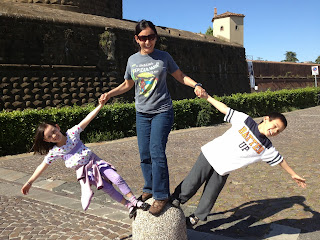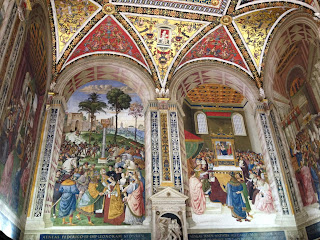Germany May 25 2012: Frankfurt
We planned out
a couple of long weekends prior to our move back to the US. For the first long weekend, we went back to
Germany. We had visited much of Germany
already, but could not completely say goodbye without visiting Frankfurt.
Frankfurt is
the business and financial center of Germany.
It has a very futuristic skyline, dominated by the twin towers of the
Deutche Bank headquarters known as “debit and credit”.
Frankfurt is
the most diverse city in Germany and has the highest percentage of foreigners
in the country: about 25% (660,000) of Frankfurt's residents have no German
passport and another 20% are naturalized German citizens.
We decided that
we would also visit nearby Koln on this trip, so while in Frankfurt, we used a
hop on hop off bus to get around and kept our sightseeing to the highlights:
- Römerberg - is the old centre of Frankfurt, with a number of historic buildings dating to the 14th and 15th century (many of which, unfortunately, were destroyed during World War II and rebuilt afterwards). The Römer itself is the town hall of Frankfurt. Next to the cathedral, at the Archäologische Garten, you can see the remains of the Roman settlements that gave this place its name. At the Römer, you can also visit the Alte Nikolaikirche (a 12th century church, taking its current form in the 15th century). Several restaurants, cafés and smaller shops can be found at the square itself and in the vicinity. Walking towards the Main river, you approach the Eiserne Steg, a 19th century bridge leading to Sachsenhausen, as well as the Rententurm (Wharfinger's Tower), a 15th century fortified tower in late Gothic style, connected to the Saalhof, an old 12th century castle building that was later modernized but never completely destroyed.
- Dom (Saint Bartholomeus' Cathedral) - The main cathedral, built in Gothic style in the 14th century on the foundation of an earlier church. From 1562 to 1792, emperors of the Holy Roman Empire were crowned in the cathedral. It is possible to ascend the spiral stairs of the 95 metre church tower.
- Eiserner Steg (Iron bridge) - Frankfurt's most well-known pedestrian bridge, built in 1869. It is just a minute away from the Römer, and provides great views of the skyline and the Main river. On the other side, you will reach Sachsenhausen, a district known for its museums and historic pubs.
- Hauptwache - A public area that is often considered the central hub of Frankfurt's modern city centre area due to its importance as a public transportation station as well as its central location, right between the main shopping street (Zeil), the Rossmarkt (another public square), and the Eschenheimer Tor. The place is named after a Baroque building ("Hauptwache") located more or less in its centre. The building was constructed in 1730 to house the local city militia, as Frankfurt was an independent city at the time. When Frankfurt became part of Prussia, the building gradually lost its original function. Since 1905, it has instead been serving as a café ("Café Hauptwache"). Other attractions include the Katharinenkirche (an old church), and the Palais Thurn-und-Taxis (an 18th century palace partially rebuilt 2004-2009).
- Alte Oper (Old Opera) - Renaissance Opera Building in the center of the city, on a busy square with fountains and cafés. Originally opened in 1880, it is not used for operas any more since the rebuilding after the war, but for concerts, congresses, and similar "fancy" events.
- Börse (Frankfurt Stock Exchange). The Frankfurt stock exchange building, which is still in use. See the bull and bear statues just outside.
- Paulskirche (St. Paul's Church) - This was the seat of the first democratically elected parliament in Germany in 1848. Like most historic buildings in the city centre, it was destroyed during World War II, but was also among the first buildings to be rebuilt after 1945 (with different interior). Today the building is used as a memorial site and an event centre, hosting e.g. the awarding of the Peace Prize of the German Book Trade.
- Sachsenhausen - By crossing one of the bridges from the city centre you reach the Sachsenhausen part of the city south of the Main river. The old town part, Alt-Sachsenhausen, at Affentorplatz is famous for its old cider bars.
We also went up
the Main Tower, which is the only Frankfurt high-rise that is open to the
public. For 5.00 Euro, you take the elevator to the viewing platform at a
height of 200 meters. From here, you have a good view of Frankfurt and the
surrounding area.
We traveled by
train to Koln (Cologne), Germany’s 4th largest city. The inner city of Cologne was completely
destroyed during World War II, along with 95% of the population.
We visited Cologne Cathedral (German: Kölner Dom), the city's most famous monument
and the Cologne residents' most respected landmark. It is a Gothic church, started in 1248, and completed in 1880. In 1996, it was designated a World
Heritage site; it houses the
Shrine of the
Three Kings, which
supposedly contains the relics of the Three Magi. Residents of Cologne sometimes refer to the
cathedral as "the eternal construction site" (die ewige Baustelle).
We also visited
the Cologne City Hall (Kölner Rathaus), founded in the 12th century, is the
oldest city hall in Germany still in use.
Cologne is well known for its beer, called Kölsch. Kölsch is also the name of the local dialect. This has led to the common joke
of Kölsch being the only language one can drink. We had some Kölsch at lunch. It comes in a small glass of maybe 8
ounces. When I asked the waiter for a
large one, he just laughed. To my
surprise, when I was close to finishing the first, the waiter brought me a
second one without asking. The waiters
walk around with a unique beer serving tray (a circular tray with a handle and
holes around the edge to carry beer glasses) and replace the empties with full
ones. It is actually a nice system that
ensures that your beer stays cold.
Cologne is also famous for Eau de Cologne (German: Kölnisch Wasser; lit: "Water of
Cologne"), a perfume created by Italian expatriate Johann Maria
Farina at
the beginning of the 18th century. During the 18th century this perfume became
increasingly popular, was exported all over Europe by the Farina family and
Farina became a household name for Eau de Cologne. In 1803 Wilhelm Mülhens
entered into a contract with an unrelated person from Italy named Carlo
Francesco Farina who granted him the right to use his family name and Mühlens
opened a small factory at Cologne's Glockengasse. In later years and after
various court battles his grandson Ferdinand Mülhens had to abandon the name Farina for the company
and their product. He decided to use the house number given to the factory at
Glockengasse during French occupation in the early 19th century, 4711. Today, original Eau de Cologne is still
produced in Cologne by both the Farina family, currently in the eighth generation, and by Mäurer & Wirtz who bought the 4711 brand in 2006. We paid a visit to the Farina Fragrance Museum – birthplace of Eau de Cologne. They
were not offering tours in English that day, so we just looked around the
museum.


























































